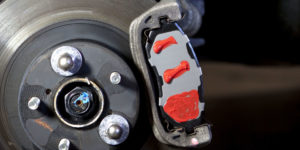
What does it mean if your Brake Warning Light is on? If the light is on all the time, it could mean you simply forgot to release the parking (emergency) brake. The brake warning light remains on when the brake is set as a reminder. If the brake warning light remains on when the parking brake is released, then something is amiss. In some cases, the brake warning light may remain on if the switch on the parking brake pedal or lever is misadjusted. Nothing is wrong with the brakes and a simple adjustment should fix the problem.
If the brake warning light comes on when you apply the brakes, or is on continuously, it means that hydraulic pressure has been lost in one side of the brake system or that the fluid level in the master cylinder is dangerously low (due to a leak somewhere in the brake system). In either case, the fluid level in the master cylinder should be checked. Adding brake fluid to the master cylinder reservoir may temporarily solve the problem. But if there’s a leak, the new fluid will soon be lost and the warning light will come back on.
On some cars, there is a fluid level sensor in the master cylinder fluid reservoir. If the fluid level is low, it will cause you brake warning light to come on.
Brake fluid leaks are serious because a leak can result in brake failure!
The brakes need to be inspected as soon as possible to determine why the fluid level is low. Leaks can occur in brake hoses, brake lines, disc brake calipers, drum brake wheel cylinders or the master cylinder itself. Wet spots at hose or line connections would indicate a leak that needs to be fixed.
WARNING: If your brake pedal is low, or you have to pump the brakes repeatedly to stop your vehicle, your brakes may be failing. Do NOT drive your vehicle. Have it towed to a service facility for repairs.
Leaking brake fluid can also contaminate the brake linings, causing them to slip or grab. The uneven braking action that results may cause the vehicle to veer to one side when the brakes are applied. Brake shoes or pads that have been contaminated with brake fluid cannot be dried out and must be replaced.
BRAKE WARNING LIGHT CIRCUIT
The brake system is divided into two hydraulic circuits. On most rear-wheel drive vehicles, it is divided so one circuit applies the front brakes and the other applies the rear brakes. On front-wheel drive cars and minivans, the system is usually split diagonally. One circuit works the right front and left rear brake, and the other works the left front and right rear brake. This is done for safety purposes so if one circuit loses all its brake fluid and fails, the vehicle will still have one remaining circuit to apply two wheel brakes.
Usually located on the master cylinder or the brake lines exiting the master cylinder is a “pressure differential” switch. If either brake circuit develops a leak and loses its fluid, the difference in pressure when the brakes are applied will trip the differential switch causing the brake warning light to come on.
ABS WARNING LIGHT
On vehicles equipped with antilock brakes (ABS), a second warning light is provided to warn if a problem occurs within the ABS system. The ABS lamp comes on when the ignition is turned on for a bulb check, then goes out after the engine starts. If the ABS warning light remains on or comes on while driving, it indicates a fault has occurred in the ABS system.
What happens next depends on the nature of the fault. On most applications, the ABS system disables itself if the ABS warning light comes on and remains on. This should have no effect on normal braking. Even so, ABS will NOT be available in an emergency situation or when braking on a wet or slick surface.
CAUTION: If the brake warning light also comes on and remains on while the ABS warning light it on, it signals a serious problem. Your vehicle may not be safe to drive. The brakes and ABS system should be inspected immediately to determine the nature of the problem!
If the ABS light comes on momentarily then goes out, the nature of the problem is usually minor and the ABS system usually remains fully operational. Some vehicle manufacturers call this kind of fault a “nonlatching” fault (meaning it isn’t serious enough to disable the ABS system).
Regardless of the type of fault that occurred to trigger the ABS warning lamp, a trouble code is recorded in the ABS module’s memory to aid in diagnosing the problem. A scan tool is usually required to read this code, though on some older vehicles the code can be read by putting the ABS system into a special diagnostic mode. The code number is then flashed out through the ABS warning lamp. The code number refers to a diagnostic chart in a service manual that must be followed to pinpoint the faulty component. Diagnosing ABS problems requires a fair amount of knowledge and expertise (as well as special equipment in many applications), so this job is best left to a competent professional.
SOURCE: aa1car
